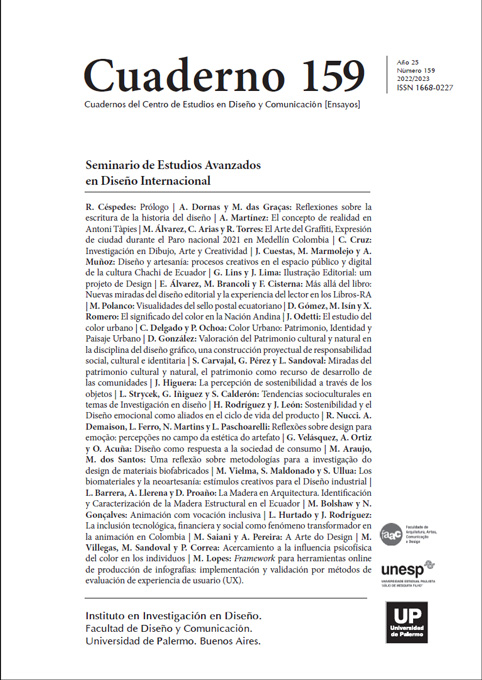Investigación en Dibujo, Arte y Creatividad. Descripción de diversas casuísticas
Abstract
This article represents a synthesis of the particular research stage, carried out from the drawing area, and within the framework of product design and artistic creation; in this way, he tries to illustrate research in artistic areas, and in particular drawing. Drawing is an expressive means of artistic language that allows to represent the Form, for different functions and contexts. It can serve to represent both what is observed, as the imagined or a devised speech. Research in drawing can be oriented towards various factors that enable innovation: Developing new models, applying new production methodologies or from the educational field, or from a multidisciplinary exercise, which could enable the creation of patents, utility models, ... This article, aims to shed light on these different research assumptions.
References
Bardisa, L. (1992). Cómo enseñar a los niños ciegos a dibujar. Madrid: ONCE.
Cruz, C. J. (2009) Un estudio sobre la Aplicación de una metodología Optoháptica de dibujo, en el programa de la Universidad de Mayores de la Universidad de Extremadura (España). Actas de Diseño. Facultad de Diseño y Comunicación, 7, 229 - 232
Cruz, C. J. (2013) Idear la Forma: Capacitación creativa. Cuadernos del Centro de Estudios en Diseño y Comunicación. Ensayos, 43, 113-125.
Cruz, C. J., González, A. G., & de Vega, F. F. (2019). Hacia un ontológico de Creatividad aplicado al contexto del Diseño y Artesanía: Innovación y Computación Evolutiva. i+ Diseño. Revista científico-académica internacional de innovación, investigación y desarrollo en Diseño, 14, 266-276.
Cruz, C. J. (2020) Esculpir la Forma. Una metodología secuencial de dibujo para la enseñanza del diseño de producto. Actas de Diseño, 36, 329-332.
Cruz, C. J. (2021) Dibujar la Forma en el Espacio. Ejercicios de Desarrollo Secuencial para el adiestramiento creativo en el Diseño de Producto. Cuadernos del Centro de Estudios en Diseño y Comunicación. Ensayos, 140, 199-213.
Cruz, J. C., González, A. G., & de Vega, F. F. (2019). Hacia un ontológico de Creatividad aplicado al contexto del Diseño y Artesanía: Innovación y Computación Evolutiva. i+ Diseño. Revista científico-académica internacional de innovación, investigación y desarrollo en Diseño, 14, 266-276.
De Vega, F.F., C. Cruz, L. Navarro, P. Hernández, T. Gallego, and L. Espada. (2014). Unplugging evolutionary algorithms: An experiment on human-algorithmic creativity. Genetic Programming and Evolvable Machines 15 (4): 379–402.
De Vega F.F., Cruz C., Hernández P., García-Valdez M. (2021) Looking for Emotions in Evolutionary Art. In: Castillo O., Melin P. (eds) Fuzzy Logic Hybrid Extensions of Neural and Optimization Algorithms: Theory and Applications. Studies in Computational Intelligence, vol 940. Springer, Cham. https://doi.org/10.1007/978-3-030-68776-2_11
Dorst, K. & Cross, N. (2001). Creativity in the design process: co-evolution of problemsolution. Design Studies, 22(5), 425-437.
Ham, D. A. (2016). How Designers Play: The Ludic Modalities of the Creative Process. Design Issues, 32(4), 16-28.
Hernández, P., De Vega, F. F., Cruz, C. J., Albarrán, J. V., García-Valdez, M., Gallego, T., García, I. A. (2017). The Horizon project: “Emotion in lines”. Open Science 1, 1 – 9. https://doi.org/10.21494/ISTE.OP.2017.0178
Lieberman, J. N. (2014). Playfulness: Its relationship to imagination and creativity. New York: Academic Press.
MARÍN, R., LAIGLESIA, J. F. y TOLOSA, J. L. (1998): La investigación en Bellas Artes. tres aproximaciones a un debate. Grupo Editorial Universitario. Granada.
Mihaly, C. (1996). Creativity: Flow and the psychology of discovery and invention. HarperPerennial..
Norman, D. A. (1999). Affordance, conventions, and design. Interactions 6, 3, 38-43.
Revest (1950) Psychology and art of the blind. London: Longmans Green&Co
Varios (2017) http://merida.herokuapp.com/masonry
Los autores/as que publiquen en esta revista ceden los derechos de autor y de publicación a "Cuadernos del Centro de Estudios de Diseño y Comunicación", Aceptando el registro de su trabajo bajo una licencia de atribución de Creative Commons, que permite a terceros utilizar lo publicado siempre que de el crédito pertinente a los autores y a esta revista.


